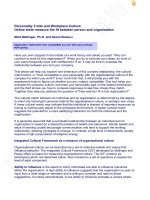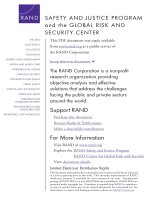Small Businesses and Workplace Fatality Risk pptx
Bạn đang xem bản rút gọn của tài liệu. Xem và tải ngay bản đầy đủ của tài liệu tại đây (633.02 KB, 104 trang )
This document and trademark(s) contained herein are protected by law as indicated in a notice appearing
later in this work. This electronic representation of RAND intellectual property is provided for non-
commercial use only. Permission is required from RAND to reproduce, or reuse in another form, any
of our research documents for commercial use.
Limited Electronic Distribution Rights
This PDF document was made available from www.rand.org as a public
service of the RAND Corporation.
6
Jump down to document
THE ARTS
CHILD POLICY
CIVIL JUSTICE
EDUCATION
ENERGY AND ENVIRONMENT
HEALTH AND HEALTH CARE
INTERNATIONAL AFFAIRS
NATIONAL SECURITY
POPULATION AND AGING
PUBLIC SAFETY
SCIENCE AND TECHNOLOGY
SUBSTANCE ABUSE
TERRORISM AND
HOMELAND SECURITY
TRANSPORTATION AND
INFRASTRUCTURE
WORKFORCE AND WORKPLACE
The RAND Corporation is a nonprofit research
organization providing objective analysis and effective
solutions that address the challenges facing the public
and private sectors around the world.
Visit RAND at www.rand.org
Explore Kauffman-RAND Center for the
Study of Small Business and Regulation
View document details
For More Information
Purchase this document
Browse Books & Publications
Make a charitable contribution
Support RAND
This product is part of the RAND Corporation technical report series. Reports may
include research findings on a specific topic that is limited in scope; present discus-
sions of the methodology employed in research; provide literature reviews, survey
instruments, modeling exercises, guidelines for practitioners and research profes-
sionals, and supporting documentation; or deliver preliminary findings. All RAND
reports undergo rigorous peer review to ensure that they meet high standards for re-
search quality and objectivity.
Small Businesses and
Workplace Fatality Risk
An Exploratory Analysis
John Mendeloff, Christopher Nelson, Kilkon Ko,
Amelia Haviland
Supported by the Ewing Marion Kauffman Foundation
The RAND Corporation is a nonprofit research organization providing objective analysis
and effective solutions that address the challenges facing the public and private sectors
around the world. RAND’s publications do not necessarily reflect the opinions of its
research clients and sponsors.
R
®
is a registered trademark.
© Copyright 2006 RAND Corporation
All rights reserved. No part of this book may be reproduced in any form by any electronic or
mechanical means (including photocopying, recording, or information storage and retrieval)
without permission in writing from RAND.
Published 2006 by the RAND Corporation
1776 Main Street, P.O. Box 2138, Santa Monica, CA 90407-2138
1200 South Hayes Street, Arlington, VA 22202-5050
4570 Fifth Avenue, Suite 600, Pittsburgh, PA 15213-2612
RAND URL: />To order RAND documents or to obtain additional information, contact
Distribution Services: Telephone: (310) 451-7002;
Fax: (310) 451-6915; Email:
The research described in this report was conducted within the RAND Institute for Civil
Justice under the auspices of the Kauffman-RAND Center for the Study of Regulation and
Small Business. This research was supported by the Ewing Marion Kauffman Foundation.
Library of Congress Cataloging-in-Publication Data
Small businesses and workplace fatality risk : an exploratory analysis / John Mendeloff [et al.].
p. cm.—(TR ; 371)
Includes bibliographical references.
ISBN 0-8330-3944-X (pbk. : alk. paper)
1. Industrial accidents. 2. Occupational mortality. 3. Small business. 4. Industrial safety.
I. Mendeloff, John. II. Series: Technical report (Rand Corporation) ; 371.
HD7262.S59 2006
363.11—dc22
2006009575
iii
e RAND Institute for Civil Justice is an independent research program within the RAND
Corporation. e mission of the RAND Institute for Civil Justice (ICJ), a division of the
RAND Corporation, is to improve private and public decisionmaking on civil legal issues by
supplying policymakers and the public with the results of objective, empirically based, analytic
research. ICJ facilitates change in the civil justice system by analyzing trends and outcomes,
identifying and evaluating policy options, and bringing together representatives of different
interests to debate alternative solutions to policy problems. ICJ builds on a long tradition of
RAND research characterized by an interdisciplinary, empirical approach to public policy
issues and rigorous standards of quality, objectivity, and independence.
ICJ research is supported by pooled grants from corporations, trade and professional asso-
ciations, and individuals; by government grants and contracts; and by private foundations. e
Institute disseminates its work widely to the legal, business, and research communities, and to
the general public. In accordance with RAND policy, all Institute research products are sub-
ject to peer review before publication. ICJ publications do not necessarily reflect the opinions
or policies of the research sponsors or of the ICJ Board of Overseers.
e Kauffman-RAND Center for the Study of Regulation and Small Business,
which is housed within the RAND Institute for Civil Justice, is dedicated to assessing and
improving legal and regulatory policymaking as it relates to small businesses and entrepreneur-
ship in a wide range of settings, including corporate governance, employment law, consumer
law, securities regulation, and business ethics. e center’s work is supported by a grant from
the Ewing Marion Kauffman Foundation.
Information about the RAND Institute for Civil Justice is available online (http://www.
rand.org/icj). Inquiries about research projects should be sent to the following address:
Robert T. Reville, Director
RAND Institute for Civil Justice
1776 Main Street
P.O. Box 2138
Santa Monica, CA 90407-2138
310-393-0411 x6786; fax 310-451-6979
Information about the Kauffman-RAND Center for the Study of Regulation and Small
Business is available online ( Inquiries about
research projects should be sent to the following address:
Susan Gates, Director
Kauffman-RAND Center for the Study of Regulation and Small Business
1776 Main Street
P.O. Box 2138
Santa Monica, CA 90407-2138
310-393-0411 x7452; fax 310-451-6979
v
Preface
A range of federal policies seeks to reduce regulatory burdens on small businesses. e Small
Business Regulatory Enforcement Fairness Act of 1996 (SBREFA) and its predecessor, the
Regulatory Flexibility Act of 1980, for example, seek to increase the weight given to small-
business concerns in the regulatory rulemaking and enforcement processes. Similarly, the
Occupational Safety and Health Administration (OSHA) exempts workplaces with fewer than
11 workers from regular “programmed” inspections, considers firm size when assessing penal-
ties, and runs a consultation program for firms with fewer than 500 workers. While previous
research suggests that small establishments (work sites) have much higher rates of deaths or
serious injuries than larger establishments have, we know little about injury and fatality rates
at small firms (companies). To shed light on these issues, this study examined the relationship
between fatality rate, i.e., the number of deaths per 100,000 workers, and business size, both
in terms of establishment size and firm size, for the period from 1992 to 2001.
By providing a more complete picture of risks found at both smaller establishments and
smaller firms, the research should help inform effective policies toward small businesses. e
research should be of interest to policymakers at both the state and federal levels as well as
businesses and others interested in accident prevention and compensation issues. e work was
completed under the auspices of the Kauffman-RAND Center for the Study of Regulation and
Small Business and was funded by the Ewing Marion Kauffman Foundation.
Contents
vii
Preface v
Figures
ix
Tables
xi
Summary
xiii
Acknowledgments
xxiii
Abbreviations
xxv
CHAPTER ONE
Introduction 1
Why Size Might Make a Difference
2
Employer Investments in Safety Might Reflect Costs and Benefits of Safety Measures
2
Costs and Benefits Might Be Related to Size
3
Previous Research on Size and Risk
6
Fatalities and Other Serious Injuries
6
Less-Serious Injuries
7
Accident Types and Size
8
Underreporting and Size
8
Focus of is Study
9
Organization of is Report
10
CHAPTER TWO
Data and Methods 11
Numerator Data
11
Denominator Data
14
Regression Analyses
15
Violation Data
16
Event-Type Data
17
CHAPTER THREE
Findings 19
Patterns in the Fatality Data from OSHA
19
e Relationship Between Fatality Rates and Establishment Size
22
Looking at More Detailed Categories of Small Establishments
23
viii Small Businesses and Workplace Fatality Risk: An Exploratory Analysis
Fatality Rates by Establishment Size in More Narrowly Defined Industries 25
e Relationship Between Fatality Rates, Firm Size, and Establishment Size
28
Controls for Other Factors
36
Causes of Fatalities in Establishments
37
OSHA Violations and Establishment Size
39
Size Distribution of Nonfatal Injury and Accident Rates
41
Tracking the Pattern of Fatality Rates by Establishment Size Over Time
42
Summary of Key Findings
44
CHAPTER FOUR
Implications for Policy and Research 47
Policy Options
47
Limitations
49
Possible Policy Interventions
50
Inspections
50
Consultation Programs
50
Information Programs
51
Focusing on Mid-Sized Firms
52
Future Research
53
APPENDIXES
A. Comparison of OSHA IMIS and CFOI Data 55
B.
Fatality Rates for All Industry Sectors
59
C.
Discussion of the Poisson Regression Analysis
63
D. Selected California Division of Occupational Safety and Health Policies and
Procedures
69
E.
e Construction Sector
71
References
73
Figures
ix
S.1. Fatality Rate by Establishment Size, by Sector xv
S.2. Fatality Rate by Establishment Size, Holding Firm Size Constant (Manufacturing)
xvi
S.3. Fatality Rate by Firm Size, Holding Establishment Size Constant (Manufacturing)
xvii
3.1. Number of Fatalities Investigated by OSHA, 1992–2001, All States
20
3.2. Fatality Rate by Establishment Size
23
3.3. Fatality Rate by Establishment Size (Small Establishments)
24
3.4. Fatality Rate by Firm Size, All States, 1992–2001
28
3.5a. Fatality Rates by Sector: Firm Size Holding Establishment Size Constant and
Establishment Size Holding Firm Size Constant (Manufacturing)
31
3.5b. Fatality Rates by Sector: Firm Size Holding Establishment Size Constant and
Establishment Size Holding Firm Size Constant (Transportation and Public Utility)
32
3.5c. Fatality Rates by Sector: Firm Size Holding Establishment Size Constant and
Establishment Size Holding Firm Size Constant (Wholesale)
33
3.5d. Fatality Rates by Sector: Firm Size Holding Establishment Size Constant and
Establishment Size Holding Firm Size Constant (Retail)
34
3.5e. Fatality Rates by Sector: Firm Size Holding Establishment Size Constant and
Establishment Size Holding Firm Size Constant (Service)
35
3.6. Poisson Regression Coefficients and eir Confidence Intervals by Each Size Level
37
3.7. Fatality Rate Changes Across ree Periods
43
C.1. Poisson Regression Coefficients and eir Confidence Intervals by Each Size Level
65
C.2. Poisson Regression Coefficients with Different Models
68
Tables
xi
1.1. Factors Affecting the Predicted Effects of Establishment and Firm Size on Safety 6
3.1. Work Fatalities Investigated by OSHA by Sector
20
3.2. Percentage of OSHA-Investigated Fatalities in Each Establishment and Firm Size
Category, All States, 1992–2001
21
3.3. Number of Nonconstruction Fatalities Investigated by OSHA, All States,
1992–2001, by Establishment and Firm Size
22
3.4a. Fatality Rates for Detailed Industries, by Size of Establishment, 1992–2001:
Manufacturing Industries
25
3.4b. Fatality Rates for Detailed Industries, by Size of Establishment, 1992–2001:
Nonmanufacturing Industries
26
3.5. Fatality Rate per 100,000 Employees (and Number of Fatalities) by Establishment
and Firm Size, Manufacturing Sector, 1992–2001
29
3.6. e Relative Frequency of Different “Events” in Fatalities in Establishments with
1–19 Employees,by Sector
38
3.7. e Percentage of Deaths Where Serious Violations Were Cited, by Establishment
Size Category, Selected Sectors, 1992–2001
40
3.8. Percentage of California Employment and Cases at Establishments with 1–19
Employees, 1992–2001, by Severity and Sector
42
A.1. “Coverage Rate” of OSHA AI Database by Sector (After Removing Highway
Motor Vehicle and Assault and Violence Accidents), 1992–2001
56
A.2. CFOI and IMIS Event Code Matching Rule
57
A.3. Coverage Rate Excluding More Categories, 1992–2001
58
B.1. Fatality Rate per 100,000 Workers by Firm and Establishment Size, 1992–2001
59
C.1. Coefficients and Confidence Intervals of Poisson Regression
66
E.1. Construction Fatality Rate Estimates per 100,000 Workers Using Different
Methods for Calculating the Rates
72
xiii
Summary
It has long been argued that the burden of health, safety, and environmental regulations falls
more heavily on small businesses than on large ones. is is important because over 55 per-
cent of Americans are employed in businesses with fewer than 100 workers. Small businesses
cannot take advantage of economies of scale and have less ability to stay aware of the volu-
minous and growing body of regulatory requirements. erefore, it is not surprising that pol-
icymakers have shown concern about the regulatory burden on small business. e Small
Business Regulatory Enforcement Fairness Act of 1996 (SBREFA) and its predecessor, the
Regulatory Flexibility Act of 1980, seek to increase the weight given to small-business concerns
in the regulatory rulemaking and enforcement processes. Similarly, the Occupational Safety
and Health Administration (OSHA) exempts workplaces with fewer than 11 workers from
regular “programmed” inspections and considers firm size when assessing penalties for viola-
tions of its safety and health standards. OSHA has also developed a consultation program for
firms with fewer than 500 workers.
Yet while concern over the regulatory burden on small business is important, policymak-
ing should also be guided by an understanding of the benefits of health, safety, and environ-
mental regulations in preventing injury and other harms. Both the burden and benefits of
regulations are likely to be affected by the magnitude of the risks at small businesses. Our
current understanding of such risks is incomplete, however. ere is a good deal of evidence
that small establishments (single physical locations at which business is conducted) have much
higher rates of deaths or serious injuries than larger establishments have (see, e.g., Mendeloff
and Kagey, 1990; Nichols, Dennis, and Guy, 1995; Fenn and Ashby, 2001), but there has been
little study regarding injury or fatality rates at small firms (e.g., businesses with a small number
of employees). Do the findings for establishment size actually represent the effects of firm size?
Or do both independently affect risks? Different preventive strategies may be appropriate if
firm size rather than establishment size is a key factor in affecting levels of risk.
To shed light on these issues, we examined the relationship between the fatality rate, i.e.,
the number of deaths per 100,000 workers, and business size, both in terms of establishment
size and firm size, for the period from 1992 to 2001. We focus on fatality rates chiefly because
we believe that underreporting of injuries is greater for less-serious injuries and that smaller
firms and establishments are especially likely to underreport. Because our study looks at both
firm size and establishment size, we are able to disentangle the effects of each.
xiv Small Businesses and Workplace Fatality Risk: An Exploratory Analysis
e analysis uses fatality data drawn from OSHA accident investigation reports, employ-
ment data from County Business Patterns (CBP) (U.S. Department of Commerce, 2006), and
a table from the U.S. Census on employment in establishment-size and firm-size combina-
tions (U.S. Census Bureau, undated). It is important to note that OSHA generally does not
investigate deaths due to highway crashes or assaults. erefore, these events are excluded here,
despite the fact that they account for almost half the deaths counted in the Census of Fatal
Occupational Injuries conducted by the Bureau of Labor Statistics (U.S. Department of Labor,
2004).
Why Size Might Make a Difference
We might expect the risks of injury to be higher at small firms for several reasons.
Smaller firms might be expected to receive lower savings from preventing injuries. e
limited actuarial experience at small firms means that they are subject to little or no expe-
rience rating by workers’ compensation insurers. us, small firms will not see reductions
in their workers’ compensation premiums even if their injury losses decline. Small firms
are also less likely to be unionized, and some evidence indicates that unions increase the
probability that workers will receive higher wages to compensate for higher risks (Viscusi,
1983). OSHA also levies reduced fines against small firms, which reduces the incentive
to correct hazards.
Smaller firms are also more likely than larger firms to employ “higher-risk” workers (i.e.,
workers who are younger, unmarried, and have lower levels of education and experience)
(Belman and Levine, 2004). ey may not pressure management on safety issues as much
as older and married workers would. ese characteristics also may make it more costly
for firms to achieve a given level of safety.
Both smaller firms and establishments will be less able to realize economies of scale in the
production of safety. Lacking in-house expertise, they may face higher marginal costs to
obtain information about risks and how to reduce them.
Smaller establishments are less likely to be inspected, reducing the marginal benefit of
compliance.
In sum, there appear to be good reasons to expect that both smaller firms and establish-
ments will exhibit higher levels of risk than will larger ones. e reasons are more numerous
and perhaps more powerful at the firm level.
Key Findings
e findings below relate primarily to the 10 years from 1992 to 2001 and are based on the
17,481 workplace fatalities investigated by OSHA.
•
•
•
•
Summary xv
The Simple Relationships Between Establishment Size and Fatality Rates and Between Firm
Size and Fatality Rates Are Both Strongly Negative
Our analysis of fatality rates among establishments of different sizes indicated that the smallest
establishments had the highest fatality rates. Figure S.1 shows the fatality rates for each estab-
lishment size category and for each of the industry sectors with the most employees and most
deaths (other than construction
1
): manufacturing, transportation and public utilities, whole-
sale trade, retail trade, and services. e figure indicates that, except in retail trade, establish-
ments with 1–19 workers had fatality rates that were 4 to 10 times higher than those in the cat-
egory with the lowest rate and 1.5 to 3 times higher than those in establishments with 20–49
employees. Further analysis indicated that, within the 1–19 category, the rates dropped sharply
as well, with rates for establishments with 1–4 workers much higher than those in establish-
ments with 5–9 workers, and higher still compared to those with 10–19. Our results, therefore,
confirm findings from earlier research on fatalities and establishment size.
2
Figure S.1
Fatality Rate by Establishment Size, by Sector
RAND TR371-S.1
Fatalities per 100K employees
8
10
0
Service
Retail
Wholesale
Transportation
and public
utility
Manufacturing
All
9
6
4
2
7
5
3
1
Sector
1–19
20–49
50–99
100–249
250–499
500–999
1,000+
Establishment
size
(employees)
1
We exclude the construction sector from some analyses because of ambiguity about the meaning of an “establishment”
in that sector.
2
We also considered the possibility that the negative relationship between fatality rates and establishment size could be
due to composition; that is, industries with higher fatality rates might happen to be those with smaller establishments.
When we examined very detailed industry categories, we still generally found that the smallest establishments had the high-
est rates. However, the decreases with size were not as great as they were at the sectoral level.
xvi Small Businesses and Workplace Fatality Risk: An Exploratory Analysis
e simple relationship between fatality rates and firm size was similar to that shown
in Figure S.1. Fatality rates also decreased with firm size, although the decreases were not as
strong or consistent as they were for establishments.
Within Firms of a Given Size, Fatality Risk Still Declines Steadily with Larger Establishment
Size, but Once We Control for Establishment Size, Firm Size Has Little Impact on Risk
e two figures below show the effects of establishment and firm size on fatality risk, holding
the other one constant. (We show the results here only for the manufacturing sector, although
results for other sectors were similar, except for retail trade.) Figure S.2 shows, for example,
that in firms with more than 1,000 employees, the fatality rate is highest for establishments
with 1–19 workers and drops substantially (although not continuously) for larger establish-
ments. e other firm-size categories in Figure S.2 show the same pattern.
Contrast the patterns in Figure S.2 with the patterns in Figure S.3, which shows how the
fatality rates of firms of different sizes vary within establishments of a given size.
For example, if we look at establishments with 1–19 workers in Figure S.3, we see that the
smallest firms (those with 1–19 workers) actually have the lowest fatality rate, not the highest.
en the rate increases with firm size until it declines for the largest firm size.
Figure S.2
Fatality Rate by Establishment Size, Holding Firm Size Constant (Manufacturing)
RAND TR371-S.2
Fatalities per 100K employees
10
100
1
500–999250–499100–24950–9920–491–19 1,000+
Firm size (employees)
1–19
20–49
50–99
100–249
250–499
500–999
1,000+
Establishment
size
(employees)
Summary xvii
Figure S.3
Fatality Rate by Firm Size, Holding Establishment Size Constant (Manufacturing)
RAND TR371-S.3
Fatalities per 100K employees
10
100
1
500–999250–499100–24950–9920–491–19 1,000+
Establishment size (employees)
1–19
20–49
50–99
100–249
250–499
500–999
1,000+
Firm size
(employees)
Effect of Firm Size Depends on Establishment Size
e pattern described here applies to the three smallest establishment-size categories in Figure
S.3. For establishments with more than 100 workers, in contrast, the smallest firm has the
highest fatality rate. So in small establishments, there appears to be something protective about
being a small firm.
Higher Rates in Small Businesses Are Related to Violations
We also considered whether the causes of fatal accidents at small establishments differed from
those at larger ones. We looked at two issues here. First, we examined whether the higher fatal-
ity rates seen at smaller establishments were related to a higher rate of fatality-causing, serious
violations of OSHA standards. Second, we considered whether accident events that are more
likely to cause death (e.g., electrocutions, explosions) were more common at small establish-
ments than at larger ones.
We found that some part of the higher fatality rates at small establishments appears to
be related to noncompliance with OSHA standards. Our findings varied somewhat for federal
OSHA states and those operating their own enforcement programs. In the former, the percent-
age of deaths with violations was higher in small establishments; in the latter, the percentages
were constant across sizes. However, because the total fatality rates are so much higher in small
establishments, even when the percentages related to violations are the same, it means that the
fatality rate due to violations is also much higher in small establishments.
xviii Small Businesses and Workplace Fatality Risk: An Exploratory Analysis
Electrocutions Are Slightly More Common in Small Establishments
We also found variation in the types of injury events that caused deaths among establishment
sizes, but these differences were not very large. Electrocutions were relatively more frequent in
establishments with 1–19 employees. us, for example, establishments with 1–19 workers had
40 percent of all deaths in a sector, but 45–50 percent of the electrocution deaths.
Fatality Rates at Small Establishments Declined Slightly Over Time Compared to Those at
Larger Establishments
We also examined establishment fatality rates by sector for three periods (1984–1989, 1990–
1995, and 1996–2002) to see whether there had been any changes in the patterns among size
categories.
3
We found that, in some sectors, death rates tended to decline somewhat for estab-
lishment sizes below 50 workers but were unchanged or increased somewhat for larger sizes.
ere was no evidence that death rates at smaller establishments were increasing relative to
larger ones.
Nonmetropolitan Location and Unionization Were Both Associated with Higher
Establishment Fatality Rates
We carried out a regression analysis (using the Poisson model) to see whether adding variables
for nonmetropolitan location and unionization affected our estimates of establishment- and
firm-size effects. To do this analysis, we had to use a different subset of the OSHA data. We
found that, while both of these variables were associated with increases in the fatality rates (40
percent for the location variable; 12 percent for the union variable), including them did not
cause changes in the estimated effects of the firm- and establishment-size variables.
Interpreting the Findings
Our study reinforces the growing body of literature indicating that small establishments tend
to have the greatest risks. We were surprised to find, however, that once we controlled for estab-
lishment size, risks did not decline steadily or strongly with increasing firm size. Establishment
size appears to have a much larger effect on fatality risks than firm size does. To the extent
that researchers have found that the simple relationship between firm size and fatality risk
is negative, the result would appear to be due to the tendency for larger firms to have larger
establishments.
In light of the reasons given for expecting risks to be highest for small firms, our findings
are puzzling. Are the increases in the financial incentives to prevent injuries that are associated
with larger firm size (e.g., experience rating under workers’ compensation) not as strong as we
3
is particular review included data only from federal OSHA states because not all the other states were submitting data
to the OSHA Integrated Management Information System (IMIS) database (the principal data source for this study) during
this period.
Summary xix
assumed? Is the assumption of economies of scale incorrect? Or are there other factors associ-
ated with firm size that offset the impact of the factors above? One possibility might be that
there are higher costs to understand and coordinate activities at multi-establishment firms.
is speculation may be related to the other unexpected finding in the study. Specifically,
we found that in small establishments, small firms had the lowest fatality rates, while in larger
establishments (over 250), the smallest firm generally had the highest rate. is pattern appeared
in most sectors.
4
What could explain it?
e only explanation that occurred to us was that this protective effect might reflect the
presence of an owner on site. Admittedly, we have no prior evidence that having an owner on
site improves safety. However, it seems plausible that an owner might, on average, feel more
responsibility to run his or her plant in a way that did not injure workers than a hired manager
would. While this explanation is speculative at this point, the pattern appears large enough to
warrant further investigation.
Finally, there is some question about how to interpret the strong relationship between risk
and establishment size. We assume that smaller establishments generate higher risks. However,
if work processes with greater inherent risks tend to get located at smaller establishments (or
firms), then the causal effect of small workplaces on risk will be overestimated.
Limitations
Our findings are subject to some important limitations. First, our largest size category, for both
establishments and firms, was 1,000 or more employees. For firms, this level is below what
would usually be required to meet self-insurance requirements under most workers’ compen-
sation laws. us, it is likely that this categorization does not give a very precise measure of
risk for the firms that may have the strongest financial incentives to prevent injuries. Second,
the OSHA data on fatalities do not include all of the relevant deaths, although we believe
that fuller reporting would show even higher relative rates at small establishments. ird, our
annual employment estimates are based on March figures, which might lead us to underesti-
mate employment at smaller establishments with high seasonal variation in employment.
Policy Options
Given the limitations of the study, more research is required to clarify its policy implications.
Nonetheless, the findings are clear enough to prompt discussion of several possible policy
interventions that might be considered to address health and safety problems at small estab-
lishments or firms. Each option is marked by uncertainty. Our goal, therefore, is to provide the
foundation for a sound debate on policy options.
Our research suggests that it may be worthwhile for OSHA to develop programs targeting
firms that employ 20–999 workers and have small establishments. As Figure S.3 showed, if a firm
4
However, the Poisson regression analysis, which used a different data set and a slightly different measure of fatality risk,
found that firm-size effects were similar for all establishment sizes. For each establishment size, the fatality rates increased
steadily with firm size until they reached the 1,000+ category, when they fell.
xx Small Businesses and Workplace Fatality Risk: An Exploratory Analysis
has between 20 and 999 workers and has small establishments (certainly below 50 and perhaps
below 99), the fatality rates in those establishments tend to be quite elevated compared to rates
in establishments with either 1–19 or over 999 workers. Rather than trying to work only at the
establishment level, OSHA might be more effective (and use fewer administrative resources) if
it began discussions at the firm level as it tries to develop an appropriate mix of tools.
A Greater Inspection Effort in Small Establishments
Although small establishments are riskier for workers, and although the fatality rates for deaths
linked to violations are also higher, it may still be difficult to justify a greater inspection effort
there. For example, even if the risks per worker were five times higher at establishments with
eight employees (the mean number in workplaces with fewer than 20), the expected benefits
in risk reduction would still be greater at a workplace with more than 40 employees (assuming
that the reduction in risk was proportional to the initial risk).
Another source of caution in making the decision to redeploy inspectors to small estab-
lishments lies in the fact that there are fixed costs associated with conducting inspections, so
that, for example, the time required to inspect an establishment with 20 workers is likely to
be more than one-fifth the time required to inspect an establishment with 100. Moreover, the
fact that death rates for establishments that have been exempted from programmed inspections
declined no less over time than rates in larger establishments casts some doubt on whether
removing the exemptions would lead to increased safety performance.
On the other hand, some studies, most recently for the 1992–1998 period (Gray and
Mendeloff, 2005) indicate that the effect of OSHA inspections on preventing injuries is greater
(in percentage terms) at smaller establishments (fewer than 100 employees) and that there was
no evidence of a preventive effect at establishments with more than 250 workers. If the latter
finding is valid, then a shift toward emphasizing inspections at smaller workplaces, including
those with fewer than 20 employees, might be justified. Unfortunately, the preventive effects
of inspections were noted only when OSHA found serious violations and assessed penalties. In
their absence, inspections, on average, had no effect or a perverse one, perhaps by signaling to
management that there were no problems that needed its attention.
Expansion of Existing Small Business Consultation Programs
OSHA already conducts a consultation program that targets smaller businesses. Another
policy option, therefore, would involve expansion of this program. Typically, there are about
25,000 consultations conducted each year, some of which include safety training. Employers
who request consultations are not cited for any violations that are found, but they do have an
obligation to abate them, and consultants are supposed to make referrals to OSHA when they
do not.
However, evidence on the effectiveness of consultations is sparse. Mendeloff and Gray
(2001) found declines after consultations for both violations (a large effect) and injuries
(a small effect), compared to establishments without consultations. However, this research
could not rule out the possibility that employers who request consultations would have made
the changes without the consultation. Moreover, the fact that consultation-program waiting
lists are short raises questions about whether there is enough unmet demand to justify expan-
Summary xxi
sion of the program. In the past, big increase in demand for consultations has occurred only
when employers thought they faced a much higher threat of inspection. However, it does seem
that state programs have some control over the demand and that it might be possible to expand
the demand moderately for consultations from smaller workplaces.
Information Programs
Based on the accident investigation data we reviewed, we believe that it may be worthwhile to
consider a trial of a new educational program that would be targeted at small establishments.
OSHA currently publishes an array of educational materials designed to assist employers to
reduce hazards. e agency also carries out education programs through cooperative activities
with trade associations.
Additional information campaigns might heighten attention to safety by reminding
employers about the workers in their industry in establishments like theirs who have died on
the job and the factors associated with these deaths. Although workplace deaths are relatively
rare, deaths may have a special salience for workers and employers alike. e infrequency of
these events seems likely to make it difficult to keep much management focus on safety, espe-
cially given the multiple and conflicting demands upon the time of a small business owner.
Information campaigns might be a means of raising and maintaining awareness.
Operationally, an employer in a specific industry category might get a list and description
of recent deaths occurring in that industry in workplaces with under 20, 50, or 100 employees.
e causal factors would be described along with any OSHA violations cited as related to the
deaths. ese deaths would be limited to those investigated by OSHA and would exclude most
highway deaths and assaults. e logic behind this approach is that employers will be more
motivated to pay attention to similar issues at their own workplaces and to take actions, includ-
ing abating hazards that might reduce the probability of such events occurring.
e effects of such an intervention might be small, but the public costs would be small as
well, probably no more than several million dollars. A crucial unknown is the level of costs that
would be incurred by small establishments in response to this initiative. If, for example, each
of 1 million small establishments spent $1,000, the total cost would be $1 billion. It would
probably make sense to begin with a pilot program in one or two states to identify the scope
and nature of the employer response.
Next Steps
As suggested in its title, this report is intended as exploratory and suggestive, not definitive.
However, we believe that the findings of this study raise some interesting questions for social
scientists. e finding that the smallest firms were relatively safe raises questions about the
importance of experience rating under workers’ compensation as an incentive for safety. Other
studies have found strong effects of firm size on workers’ compensation costs, but it is possible
that many of these studies confounded firm size and establishment size.
Our finding about the different effects of firm size in small and large establishments may
raise important questions for students of entrepreneurship and of organizational behavior.
xxii Small Businesses and Workplace Fatality Risk: An Exploratory Analysis
Some further insights may be obtained by merging IMIS data with establishment-level data
from the Census of Manufactures (U.S. Census Bureau, 1999) and the analogous databases
for other industries. at match would allow clear identification of single-establishment firms
versus others.
One finding of this research was that the size patterns among establishments did some-
times vary by industry. We did not attempt to explain the reasons for these variations, but
doing so might shed valuable light on the causal factors at work.
It would also be useful to try to find out whether the poorer fatality performance of
mid-sized firms in small establishments also applied to nonfatal injuries. We are not aware
of any efforts to untangle establishment-size and firm-size effects for nonfatal injuries. Any
effort would need to take care to consider how underreporting would affect the results, but we
believe the effort would be worthwhile.
xxiii
Acknowledgments
is research was funded by a grant from the Kauffman Foundation to the RAND Corporation
for the sponsorship of research dealing with regulatory issues and small businesses.
We would like to thank four individuals and their organizations that provided data for
our study. At the Occupational Safety and Health Administration, we would like to thank
Joseph DuBois; at the U.S. Census Bureau, Melvin Cole III; at the Bureau of Economic
Analysis, U.S. Department of Commerce, John Ruser; and at the Bureau of Labor Statistics,
U.S. Department of Labor, Samuel Meyer.
We received helpful comments on an early draft of the manuscript from Wayne Gray at
Clark University and Harry Shannon at McMasters University. We would also like to thank
the participants in the October 2004 Kauffman-RAND conference on small business and
regulation for comments on an early version of this analysis. Two other reviewers, John Ruser
and Richard Buddin, provided valuable comments on the draft manuscript.
We would like to thank our RAND colleagues for their support. Susan Gates, director of
the Kauffman-RAND Center for the Study of Regulation and Small Business, provided assis-
tance and comments on our work. Joanna Nelsen and Kristin Leuschner both helped with the
editing and preparation of the manuscript.









